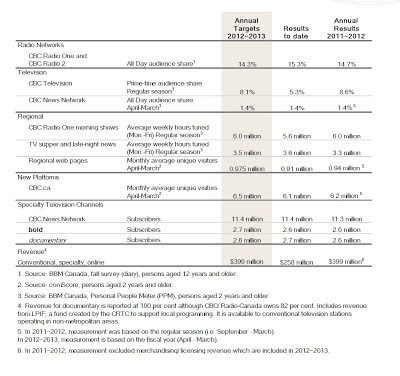The previous post expressed concerns about how CBC has been presenting results of opinion polls and online surveys. The post was sent to the CBC Ombudsman and the Executive Producer of Power and Politics was good enough to respond and explains that her program will take steps to improve how polls are presented. Her response follows and afterwards are my comments to the producer:
From: Amy Castle
Sent: Tuesday, December 24, 2013 11:56 AM
To: bkiefl
Cc: CBC Ombudsman
Subject: Letter to CBC Ombudsman
To: bkiefl
Cc: CBC Ombudsman
Subject: Letter to CBC Ombudsman
Dear Mr
Kiefl,
| Thank you for sharing your recent blog post with the CBC Ombudsman regarding Power & Politics. As the Executive Producer, I can tell you your feedback is essential to how we do our work. I must, however, disagree strongly with your suggestion that our program is "ignoring a vital area of CBC journalistic policy." On the contrary, we're very much living up to our Journalistic Standards and Practices. |
Let me respond to each of them in turn.
with Jaime Watt, you say “CBC should not be implying that this is
representative of Canadians and therefore possibly leading viewers into
thinking that Navigator has conducted representative polling.”
Rather, we are clear on the show and on our website that Jaime Watt is
tracking the political conversation in Ottawa
and across Canada.
The goal of the segment is to discuss which political issues are trending
in the Canadian conversation, and to highlight the differences - if any - in
the conversation being held in Ottawa
compared to the national conversation.
I am attaching to this note a detailed breakdown of that
methodology.
about the methodology used by Navigator.” Although we have the
methodology on our website, I will ensure that we remind our viewers on air
where to find details of that methodology.
draws on a number of polls from reputable sources and we are always clear where
the polls come from.
methodology meets CBC standards. The sample size, methodology and
interpretation of results of non–CBC polls should be reviewed by the CBC
research department. To help our audience place a poll in context, we provide
relevant information about the methodology and size of the sample along with
the results. Where applicable, we provide the margin of error.
used in the Nanos Number meet CBC standards. We also provide information
on the methodology, size of the sample and margin of error. These details
are clearly stated on our website http://www.cbc.ca/news/politics/the-nanos-number-1.1134156
read when we post it on television. This is due to a new graphics programme
that we recently started using. I am currently working with our graphics
designer to ensure that our graphics are upgraded to ensure that the font is
more easily readable on air.
In fact the term crowdsource is a Nanos tradename and should not be
confused with a process. The Nanos polling methodology includes a sample
of random land and cell lines where people are randomly selected to do a study
online. His methodology is robust and meets our strict CBC standards.
audience is an important part of our show. We welcome comments from
viewers, and encourage participation in our daily political conversation.
The Ballot Box is an important part of that interaction.
mentioned, we are transparent in showing the number of votes on screen whenever
the Ballot Box appears.
online along with the percentage results at the end of each day.
responsibility to tell you that if you are not satisfied with this response,
you may wish to submit the matter for review by the CBC Ombudsman. The
Office of the Ombudsman, an independent and impartial body reporting
directly to the President, is responsible for evaluating program compliance
with the CBC's journalistic policies. The Ombudsman may be reached by
mail at Box 500,
Terminal A, Toronto, Ontario M5W 1E6,
or by fax at (416) 205-2825, or by e-mail at ombudsman@cbc.ca.
Sincerely,
Amy Castle
Executive Producer, Power and Politics
Executive Producer, Power and Politics
CBC News Network
www.cbc.ca/politics
www.cbc.ca/politics
My Response to the Executive Producer of Power and Politics:
Ms. Castle, thank you for the response. Below are my comments and concerns:
- Navigator or Political Traction: Your suggestion of “…ensur(ing) that we remind our viewers on air where to find details of th(e) methodology” would be beneficial and resolve my concern about Navigator. Putting that information on your web site is good but an on-air explanation is excellent. I suspect only a handful of viewers have ever seen the web site reference.
- Nanos Number: I think it is good that you are “currently working with (y)our graphics designer to ensure that…graphics are upgraded to ensure that the font is more easily readable on air.” However, while I recognize that this would improve the viewer’s understanding of the polling methodology, the spirit of the policy on reporting polls would be better reflected if you did more than include a graphic, legible or not, with sampling details, etc. A half minute explanation of the methodology is warranted and would add credibility to what Mr. Nanos says about results. Mr. Nanos also appeared recently with Evan Solomon on The House and discussed poll results dealing with the PM’s credibility; there was scant reference to polling methodology. Poll results from an unspecified source dealing with CPP were reported on December 16, 2013 on CBC News Network and again, there was no reference to methodology. So, this appears to be a wider issue than the Nanos Number on Power and Politics and I would appreciate your alerting Jennifer McQuire to this concern.
- The Ballot Box: the policy dealing with online surveys, which I had a hand in drafting, was to ensure that viewers/listeners understood specifically that such “surveys” are not scientific in any way. The policy was to make that absolutely clear and so I suggest you include a reference to Ballot Box being unscientific each time you present the results in graphic form on air. Moreover, my understanding of the policy dealing with online surveys is that only raw vote numbers will be presented; percentages will not be presented under any circumstances. I appreciate your offer to “ensure that the number of votes gets posted online along with the percentage results at the end of each day.” But I believe this is a misinterpretation of the policy. Percentages should not be presented in any form. To quote from the policy: “We report the results by giving the number of votes cast for each option. We do not give the results as a percentage, as we do with bona fide polls.” So, including raw numbers on air and on your web site follows the policy but including percentages with or without the raw numbers violates the spirit and the letter of the policy. I note that a number of CBC programs are using online surveys and all of them violate the policy by including just percentages on their web sites. These include Day Six, Q and The National and I would appreciate your also bringing this to the attention of Jennifer McQuire. (The online survey by The National gives percentages to two decimal places, giving the impression the results are especially accurate.)
While the above may seem like nitpicking to someone producing a show as fast moving and well produced as Power and Politics, I assure you that my concerns about CBC journalistic policy are much greater than how polls are presented. CBC journalism has always occupied the high ground and relaxing journalistic standards only plays into the hands of critics who want to get the CBC on their ‘level playing field’. I firmly believe that the future of the CBC will be determined by the quality of its journalism and slippage in journalistic standards will spell the end of CBC TV and radio.
Barry Kiefl
.PNG)







































